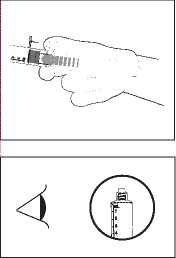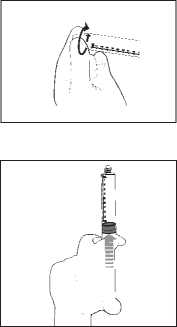Adrenaline 1Mg/10Ml (1:10 000) Solution For Injection In Pre-Filled Syringe
Package leaflet: Information for the patient ADRENALINE 1 mg/10 ml (1:10,000), solution for injection in pre-filled syringe
(Referred to as ‘Adrenaline injection’ in this leaflet)
A
AGUETTANT
Read all of this leaflet carefully before you start using this medicine because it contains important information for you.
- Keep this leaflet. You may need to read it again.
- If you have any further questions, ask your doctor, pharmacist or nurse.
- This medicine has been prescribed for you only. Do not pass it on to others. It may harm them, even if their signs of illness are the same as yours.
- If you get any side effects, talk to your doctor, pharmacist or nurse. This includes any possible side effects not listed in this leaflet. See section 4.
What is in this leaflet:
1. What Adrenaline injection is and what it is used for
2. What you need to know before you are given Adrenaline injection
3. How Adrenaline injection is given
4. Possible side effects
5. How to store Adrenaline injection
6. Contents of the pack and other information
1. What Adrenaline injection is and what it is used for
Adrenaline Injection belongs to a group of medicines called adrenergic and dopaminergic agents.
This medicine is used for:
- Treatment of cardiac arrest (unexpected loss of heart function, breathing and consciousness),
- Treatment of acute anaphylaxis in adults (serious shock or collapse produced by a severe allergic reaction).
2. What you need to know before you are given Adrenaline injection
You must not be given Adrenaline injection
If you are allergic (hypersensitive) to any ingredients of this medicine (listed in section 6) where an alternative presentation of Adrenaline or alternative vasopressor is available.
Warnings and precautions
Adrenaline injection is indicated for emergency treatment. Continuous medical supervision is necessary after administration.
Precautions for use
The risk of side effects is increased if you:
- have medical history of hyperthyroidism (disease of the thyroid gland),
- have severe renal insufficiency,
- suffer from hypercalcaemia (increase of calcium concentration in the blood),
- suffer from hypokalaemia (decrease of potassium concentration in the blood),
- have diabetes mellitus,
- have cardiac disease or arterial hypertension,
- have brain damage or hardening of the arteries in the brain,
- have glaucoma (increased pressure in the eye),
X---------------------------------
The following information is intended for healthcare professionals only:
Intravenous adrenaline should only be administered by those experienced in the use and titration of vasopressors in their normal clinical practice.
Cardiopulmonary resuscitation:
10 ml of the 1:10,000 solution (1 mg) by the intravenous or intraosseous route, repeated every 3-5 minutes until return of spontaneous circulation.
Endotracheal use should only be considered as a last resort if no other route of administration is accessible, at a dose of 20 to 25 ml of the 1:10,000 solution (2 to 2.5 mg).
In cardiac arrest following cardiac surgery, Adrenaline should be administered intravenously in doses of 0.5 ml or 1 ml of 1:10,000 solution (50 or 100 micrograms) very cautiously and titrated to effect.
Acute anaphylaxis
Titrate using intravenous boluses of 0.5 ml 1:10,000 solution (0.05 mg) according to response.
Adrenaline 1 mg/10 ml (1:10,000) solution for injection in pre-
- have prostate disorders,
- are elderly,
- are pregnant.
Other medicines and Adrenaline injection
Tell your doctor if you are taking, have recently taken or might take any other medicines.
Medicines that may interact with Adrenaline injection include:
- Volatile halogen anaesthetics (gas used during anaesthesia),
- Certain antidepressants,
- Drugs to treat high blood pressure, heart conditions,
- Drugs to treat diabetes.
Pregnancy and breast-feeding
If you are pregnant or breast-feeding, think you may be pregnant or are planning to have a baby, ask your doctor, pharmacist or nurse for advice before you are given this medicine.
Driving and using machines
Having Adrenaline injection does not affect your ability to drive or use machines.
Adrenaline injection contains sodium
This medicinal product contains 3.54 mg of sodium per ml of solution for injection. This needs to be taken into consideration by patients on strict sodium diet.
3. How Adrenaline injection is given
Adrenaline injection is administered to you by your doctor, nurse or paramedic. They will have to decide the correct amount for you and when and how this should be given.
In case of life threatening allergic reactions (acute anaphylaxis):
Adults will be given a dose of 0.05 mg (0.5 ml of Adrenaline 1:10,000 solution) repeated as necessary until the desired response is achieved.
In case of cardiac arrest:
Adults: 1 mg (10 ml of Adrenaline 1:10,000 solution) is given into a vein or into a bone every 3-5 minutes until the heart starts to work.
Children above 5 kg: 10 micrograms/kg (0.1 ml/kg of Adrenaline 1:10,000 solution) is given into a vein or into a bone every 3-5 minutes until the heart starts to work.
This medicinal product is not suitable for delivering a dose of less than 0.5 ml and should therefore not be used in neonates and infants for which the body weight is less than 5 kg.
filled syringe is not recommended for intramuscular use in acute anaphylaxis. For intramuscular administration, a 1 mg/ml (1:1000) solution should be used Paediatric Population:
This medicinal product is not appropriate to deliver a dose of less than 0.5 ml and should therefore not be used by the intravenous or intraosseous route, in neonates and infants with body weight less than 5 kg.
Cardiac arrest in children:
Intravenous or intraosseous route (above 5 kg only): 0.1 ml/kg of 1:10,000 solution (10 micrograms/kg) to a maximum single dose of10 ml of1:10,000 solution (1 mg), repeated every 3-5 minutes until return of spontaneous circulation.
Endotracheal use (any body weight) should only be considered as a last resort if no other route of administration is accessible, at a dose of 1 ml/kg of 1:10,000 solution (100 micrograms/kg) to a maximum of single dose of 25 ml of1:10,000 solution (2.5 mg).
Strictly respect the protocol below :
The pre-filled syringe is for single patient use only. Discard the syringe after use. Do not reuse.
4. Possible side effects
Like all medicines this medicine can cause side effects, although not everybody gets them.
The following side effets have been reported:
- anxiety,
- dyspnoea (difficulty in breathing),
- nervousness,
- fear,
- sweating,
- palpitations (irregular or faster heart beat),
- tachycardia (increased heart rate),
- pallor,
- tremors,
- weakness,
- dizziness,
- headache,
- nausea,
- vomiting,
- coldness of the extremities,
- hallucinations,
- syncopes,
- hyperglycaemia (high blood sugar levels),
- hypokalaemia (low potassium levels in the blood),
- metabolic acidosis (increased acidity in the blood),
- mydriasis (dilatation of the pupil).
In high dosages or for patients sensitive to adrenaline, side effects are:
- cardiac dysrhythmia (irregular heartbeats/cardiac arrest),
- hypertension (with risk of cerebral haemorrhage),
- vasoconstriction (narrowing of the blood vessels for example cutaneous, in the extremities or kidneys),
- acute angina attacks,
- risk of acute myocardial infarction.
Repeated local injections may produce necrosis (tissue damage) at the site of injection as a result of vascular constriction (blood vessel constriction).
In all cases, after administration of Adrenaline injection medical supervision is necessary.
Reporting of side effects
If you get any side effects, talk to your doctor, pharmacist or nurse. This includes any possible side effects not listed in this leaflet. You can also report side effects directly via Yellow Card Scheme - Website: www.mhra.gov.uk/yellowcard. By reporting side effects you can help provide more information on the safety of this medicine.
5. How to store Adrenaline injection
Keep out of the sight and reach of children.
You should not be given this medicine after the expiry date which is stated on the label. The expiry date refers to the last day of the month. Your doctor or nurse will check this.
Do not store above 25°C.
Store in the aluminium pouch in order to protect from light and oxygen.
Do not open the aluminium pouch until use.
After opening the pouch the product must be used immediately.
Do not freeze.
Do not use sharp instruments to open the pouch.
You should not be given Adrenaline injection if it has been partly used or shows signs of visible damage.
Do not throw away any medicines via wastewater or household waste. Ask your pharmacist how to throw away medicines you no longer use. These measures will help protect the environment.
6. Content of the pack and other information
What Adrenaline injection contains
The active ingredient is adrenaline tartrate:
Each ml of solution for injection contains 0.1 mg of adrenaline (as adrenaline tartrate).
Each 10 ml pre-filled syringe contains 1 mg adrenaline (as adrenaline tartrate).
The other ingredients are sodium chloride, hydrochloric acid, sodium hydroxide, water for injections.
What Adrenaline injection looks like and contents of the pack
Adrenaline injection is a clear, colourless solution in a 10 ml polypropylene pre-filled syringe, individually packed in a transparent blister and overwrapped in an aluminium pouch.
The pre-filled syringes are available in boxes of 1 and 10 syringes.
Not all pack sizes may be marketed.
Marketing Authorisation Holder and Manufacturer
Marketing Authorisation Holder:
Laboratoire AGUETTANT 1, rue Alexander Fleming 69007 LYON France
Distributed by:
AGUETTANT Ltd.
N°1, Farleigh House - Flax Bourton BRISTOL - BS48 1UR - United Kingdom
This leaflet was last revised in 12/2015.
Detailed information on this medicinal product is available on the Medicines and Healthcare Products Regulatory Agency (MHRA) website.
X--------------------------------------------------------------------
The product should be inspected visually for particles and discolouration prior to administration. Only clear colourless solution free from particles or precipitates should be used.
The product should not be used if the pouch or the blister has been opened or if the tamper evident seal on the syringe (plastic film at the basis of the end cap) is broken.
1) Tear open the aluminium pouch by hand only using the indent(s). Do not use sharp instruments to open the pouch.
2) Withdraw the pre-filled syringe from the sterile blister.

3) Push on the plunger to free the bung. The sterilisation process may have caused adhesion of the bung to the body of the syringe.
5) Check the syringe seal tip has been completely removed. If not, replace the cap and twist again.

4) Twist off the end cap to break the seals. Do not touch the exposed luer connection in order to avoid contamination.
6) Expel the air by gently pushing the plunger.
7) Connect syringe to vascular access device or to needle.
Push the plunger to inject the required volume.
Any unused product or waste material should be disposed of in accordance with local requirements.